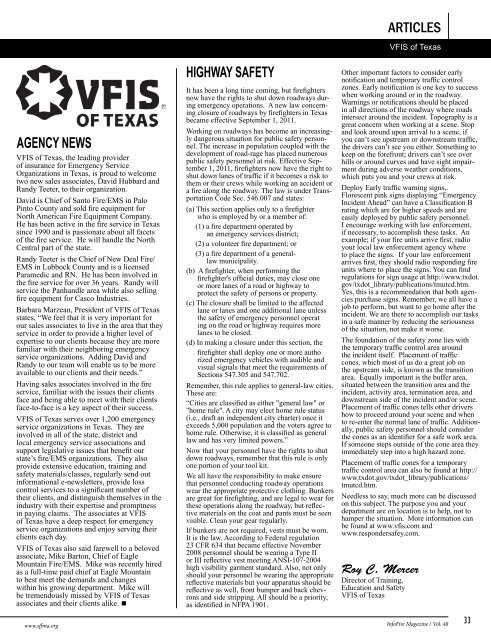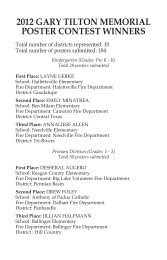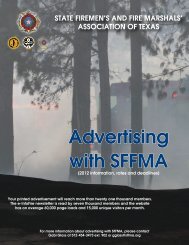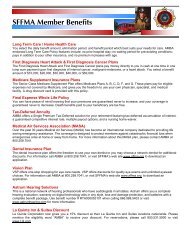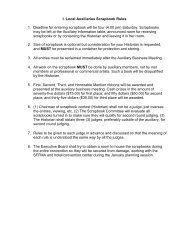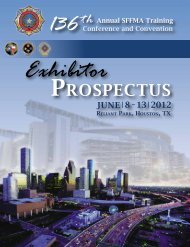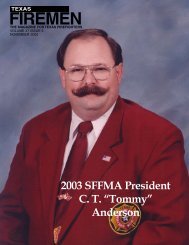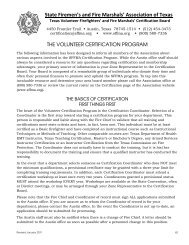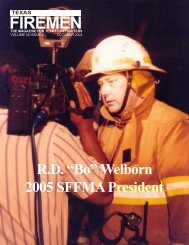April 2013 - State Firemen's & Fire Marshals'
April 2013 - State Firemen's & Fire Marshals'
April 2013 - State Firemen's & Fire Marshals'
Create successful ePaper yourself
Turn your PDF publications into a flip-book with our unique Google optimized e-Paper software.
AGENCY NEWSVFIS of Texas, the leading providerof insurance for Emergency ServiceOrganizations in Texas, is proud to welcometwo new sales associates, David Hubbard andRandy Teeter, to their organization.David is Chief of Santo <strong>Fire</strong>/EMS in PaloPinto County and sold fire equipment forNorth American <strong>Fire</strong> Equipment Company.He has been active in the fire service in Texassince 1990 and is passionate about all facetsof the fire service. He will handle the NorthCentral part of the state.Randy Teeter is the Chief of New Deal <strong>Fire</strong>/EMS in Lubbock County and is a licensedParamedic and RN. He has been involved inthe fire service for over 36 years. Randy willservice the Panhandle area while also sellingfire equipment for Casco Industries.Barbara Marzean, President of VFIS of Texasstates, “We feel that it is very important forour sales associates to live in the area that theyservice in order to provide a higher level ofexpertise to our clients because they are morefamiliar with their neighboring emergencyservice organizations. Adding David andRandy to our team will enable us to be moreavailable to our clients and their needs.”Having sales associates involved in the fireservice, familiar with the issues their clientsface and being able to meet with their clientsface-to-face is a key aspect of their success.VFIS of Texas serves over 1,200 emergencyservice organizations in Texas. They areinvolved in all of the state, district andlocal emergency service associations andsupport legislative issues that benefit ourstate’s fire/EMS organizations. They alsoprovide extensive education, training andsafety materials/classes, regularly send outinformational e-newsletters, provide losscontrol services to a significant number oftheir clients, and distinguish themselves in theindustry with their expertise and promptnessin paying claims. The associates at VFISof Texas have a deep respect for emergencyservice organizations and enjoy serving theirclients each day.VFIS of Texas also said farewell to a belovedassociate, Mike Barton, Chief of EagleMountain <strong>Fire</strong>/EMS. Mike was recently hiredas a full-time paid chief at Eagle Mountainto best meet the demands and changeswithin his growing department. Mike willbe tremendously missed by VFIS of Texasassociates and their clients alike.www.sffma.orgHIGHWAY SAFETYIt has been a long time coming, but firefightersnow have the rights to shut down roadways duringemergency operations. A new law concerningclosure of roadways by firefighters in Texasbecame effective September 1, 2011.Working on roadways has become an increasinglydangerous situation for public safety personnel.The increase in population coupled with thedevelopment of road-rage has placed numerouspublic safety personnel at risk. Effective September1, 2011, firefighters now have the right toshut down lanes of traffic if it becomes a risk tothem or their crews while working an accident ora fire along the roadway. The law is under TransportationCode Sec. 546.007 and states:(a) This section applies only to a firefighterwho is employed by or a member of:(1) a fire department operated byan emergency services district;(2) a volunteer fire department; or(3) a fire department of a generallawmunicipality.(b) A firefighter, when performing thefirefighter's official duties, may close oneor more lanes of a road or highway toprotect the safety of persons or property.(c) The closure shall be limited to the affectedlane or lanes and one additional lane unlessthe safety of emergency personnel operating on the road or highway requires morelanes to be closed.(d) In making a closure under this section, thefirefighter shall deploy one or more authorized emergency vehicles with audible andvisual signals that meet the requirements ofSections 547.305 and 547.702.Remember, this rule applies to general-law cities.These are:“Cities are classified as either "general law" or"home rule". A city may elect home rule status(i.e., draft an independent city charter) once itexceeds 5,000 population and the voters agree tohome rule. Otherwise, it is classified as generallaw and has very limited powers.”Now that your personnel have the rights to shutdown roadways, remember that this rule is onlyone portion of your tool kit.We all have the responsibility to make ensurethat personnel conducting roadway operationswear the appropriate protective clothing. Bunkersare great for firefighting, and are legal to wear forthese operations along the roadway, but reflectivematerials on the coat and pants must be seenvisible. Clean your gear regularly.If bunkers are not required, vests must be worn.It is the law. According to Federal regulation23 CFR 634 that became effective November2008 personnel should be wearing a Type IIor III reflective vest meeting ANSI-107-2004high visibility garment standard. Also, not onlyshould your personnel be wearing the appropriatereflective materials but your apparatus should bereflective as well, front bumper and back chevronsand side stripping. All should be a priority,as identified in NFPA 1901.ARTICLESVFIS of TexasOther important factors to consider earlynotification and temporary traffic controlzones. Early notification is one key to successwhen working around or in the roadway.Warnings or notifications should be placedin all directions of the roadway where roadsintersect around the incident. Topography is agreat concern when working at a scene. Stopand look around upon arrival to a scene, ifyou can’t see upstream or downstream traffic,the drivers can’t see you either. Something tokeep on the forefront; drivers can’t see overhills or around curves and have sight impairmentduring adverse weather conditions,which puts you and your crews at risk.Deploy Early traffic warning signs,.Florescent pink signs displaying “EmergencyIncident Ahead” can have a Classification Brating which are for higher speeds and areeasily deployed by public safety personnel.I encourage working with law enforcement,if necessary, to accomplish these tasks. Anexample; if your fire units arrive first, radioyour local law enforcement agency whereto place the signs. If your law enforcementarrives first, they should radio responding fireunits where to place the signs. You can findregulations for sign usage at http://www.txdot.gov/txdot_library/publications/tmutcd.htm.Yes, this is a recommendation that both agenciespurchase signs. Remember, we all have ajob to perform, but want to go home after theincident. We are there to accomplish our tasksin a safe manner by reducing the seriousnessof the situation, not make it worse.The foundation of the safety zone lies withthe temporary traffic control area aroundthe incident itself. Placement of trafficcones, which most of us do a great job onthe upstream side, is known as the transitionarea. Equally important is the buffer area,situated between the transition area and theincident, activity area, termination area, anddownstream side of the incident and/or scene.Placement of traffic cones tells other drivershow to proceed around your scene and whento re-enter the normal lane of traffic. Additionally,public safety personnel should considerthe cones as an identifier for a safe work area.If someone steps outside of the cone area theyimmediately step into a high hazard zone.Placement of traffic cones for a temporarytraffic control area can also be found at http://www.txdot.gov/txdot_library/publications/tmutcd.htm.Needless to say, much more can be discussedon this subject. The purpose you and yourdepartment are on location is to help, not tohamper the situation. More information canbe found at www.vfis.com andwww.respondersafey.com.Roy C. MercerDirector of Training,Education and SafetyVFIS of TexasInfo<strong>Fire</strong> Magazine / Vol. 4833


